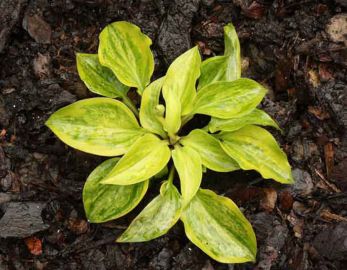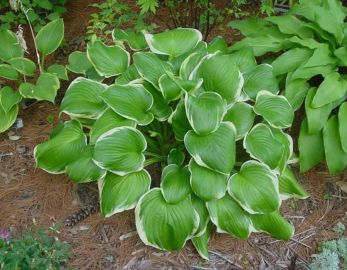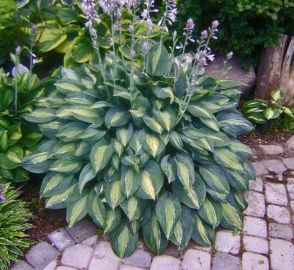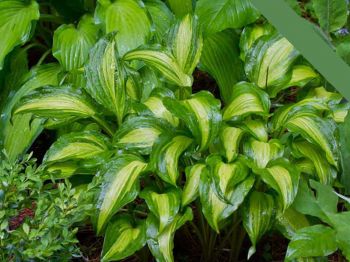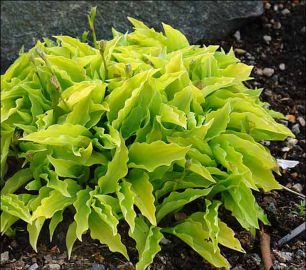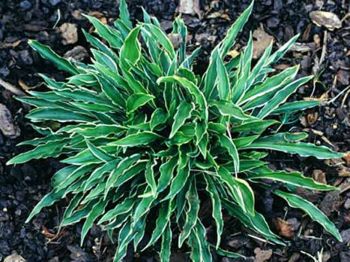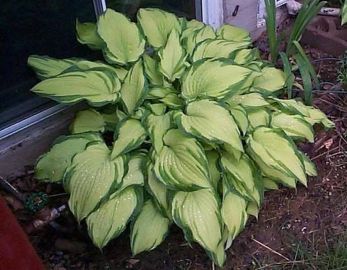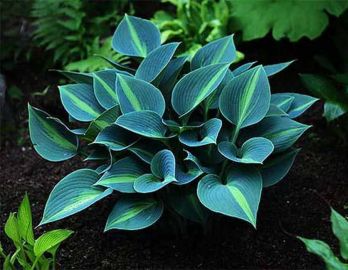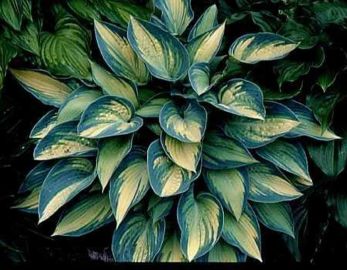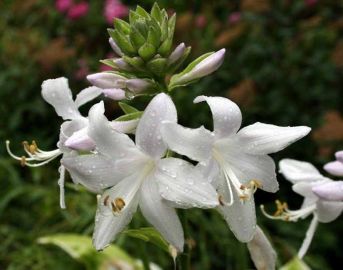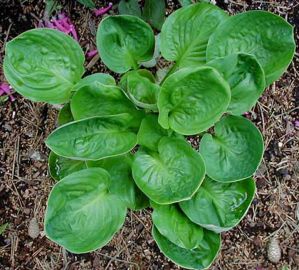Celem poradnika jest zapoznanie miłośników ogrodów w prosty i przystępny sposób z zagadnieniami związanymi z zakupem i uprawą funkii. Napisałem go w oparciu o własne doświadczenia, jak również skorzystałem z doświadczeń miłośnika host, pana Andrzeja Pacha, twórcy pierwszej polskiej internetowej encyklopedii host.
Wszystkich, którzy chcą dogłębnie poznać zagadnienia związane z uprawą tych wspaniałych roślin, jak również opisy odmian i zobaczyć piękne zdjęcia, serdecznie zapraszam na tę stronę.
Życzę sukcesów w uprawie Andrzej Marzec
TROCHĘ CIEKAWYCH INFORMACJI O FUNKIACH
- Są to długowieczne byliny. Mogą rosnąć na jednym miejscu i 100 lat, jednak w związku z tym osiągają dojrzałość w wieku 6-9 lat w zależności od odmiany. Są wśród nich olbrzymy jak i miniaturki.
- Młode rośliny bardzo często nie przypominają dorosłych egzemplarzy (mogą mieć inne kolory, inny kształt i fakturę liścia ). Szczególnie dotyczy to odmian niebieskich. Młode sadzonki tych odmian są w zasadzie zielone lub lekko zielononiebieskie.
- Wiele odmian o liściach zielonych z żółtym środkiem lub żółtych z zielonym marginesem, (np. Gold Standard, Paradigm, Color Glory) wczesną wiosną jest całkowicie zielona i dopiera pod wpływem światła, pojawia się kolor żółty. Dlatego zanim zaczniemy się martwić, że to nie ta odmiana, warto trochę poczekać.
- Nie ma odmian o niebieskich liściach. Są bardziej lub mniej niebiesko-zielone. (dużo zależy od nawożenia). Niebieski kolor roślina uzyskuje dzięki pokrywającemu jej liście woskowi. Stosowana jest nawet specjalna 5-cio stopniowa skala niebieskości funkii. Np. Halcyon uznawany jest jako bardzo niebieski i ma wysoki 2 stopień. Niebieski kolor jest najbardziej intensywny wiosną.
- Odmiany o białych liściach utrzymują ten kolor tylko na początku wiosny i stosunkowo szybko zielenieją. Wyższa temperatura i słońce przyspiesza ten proces, dlatego wymagają chłodnego cienia.
- Rozmiary funkii podawane w opisach są tylko rozmiarami orientacyjnymi. Często zdarza się, że roślina może być większa lub mniejsza. Wpływa na to wiele czynników takich jak mikroklimat, gleba, nawadnianie, nawożenie itp.
- Większość host zmienia swoje ubarwienie w trakcie sezonu.
- Jesienią liście funkii żółkną i zamierają i dzieje się to w różnym okresie w zależności od odmiany. Proces ten możemy zauważyć już we wrześniu i trwa jeszcze w październiku.
- Nie są to rośliny ekspansywne, tworzą kępy z roku na rok coraz większe, z większą ilością pędów, aż do osiągnięcia rozmiarów podanych w opisach.
- Nie wymagają specjalnej troski, można powiedzieć, że są to rośliny bezobsługowe.
CO TRZEBA ZROBIĆ BY NASZE FUNKIE DOBRZE ROSŁY I MIAŁY PIĘKNE KOLORY.
Główną ozdobą host są liście. W trakcie sezonu liść przechodzi fazy młodości, dojrzałości, starzenia i zamierania. Najważniejszy jest okres dojrzałości, w tym czasie roślina jest najpiękniejsza. Aby ten okres był jak najdłuższy musimy spełnić kilka warunków:
- Odpowiedni dobór stanowiska do odmiany
- Odpowiednie przygotowanie podłoża
- Odpowiednie nawadnianie.
- Odpowiednie nawożenie
- Odpowiednie ściółkowanie
- Odpowiednie zabiegi pielęgnacyjne
STANOWISKO
Wybór stanowiska to kluczowy element powodzenia i zadowolenia z uprawy naszych pupilków. Słońce jest czynnikiem, który umożliwia prawidłowe wybarwienie, ale również przyśpiesza starzenie się liści, lub całkowicie je niszczy, dlatego najbardziej odpowiednim stanowiskiem do uprawy funkii cień i półcień.
Przyjmujemy, że stanowisko w cieniu to takie do którego w ciągu dnia słońce dociera przez 3 godziny, a półcień ma słońce od 3 do 6 godzin. Jednak są to tylko statystyczne uogólnienia.
Cień: Z praktyki wiem, że niektóre odmiany kolorowe takie jak Color Glory, George Smith nie powinny mieć wcale bezpośredniego dostępu do promieni słonecznych, jednocześnie ich stanowisko powinno być jasne. Tak więc jeżeli mówimy o cieniu najlepiej sprawdza się stanowisko za wysoką osłoną, lub pośród drzew z wysokimi koronami ale nie rosnącymi zbyt gęsto. Miejsce gdzie jest gęsty, mroczny cień nie nadaje się do uprawy host.
Półcień: Najbardziej optymalne jest stanowisko z porannym słońcem, wtedy powietrze nie jest nagrzane i ma mniejszy wpływ na starzenie liści. Popołudniowe słońce jest już bardziej szkodliwe, ale i na takim stanowisku funkie dobrze rosną, starajmy się jednak unikać wtedy białych ścian lub murków, które dodatkowo odbijają promienie słoneczne i wysuszają liście.
Słoneczne stanowisko: Słońce ma dostęp do rośliny w godzinach południowych. To stanowisko w praktyce nie nadaje się do uprawy funkii. Może sprawdzić się ono w okresie wiosennym i wczesnym latem, ale później następuje szybkie starzenie liści. Są odmiany określane jako wytrzymujące dużą ilość słońca ale dotyczy to raczej stanowisk z porannym i popołudniowym słońcem
Poniżej link do listy funkii wytrzymujących dość dużo słońca:
Generalizując:
- Odmiany, zielone i niebieskie najlepiej rosną w cieniu i półcieniu.
- Odmiany żółte dobrze radzą sobie, ze sporą ilością porannego i popołudniowego słońca.
- Odmiany kolorowe najlepiej rosną w półcieniu.
- Odmiany bez chlorofilu takie jak White Feather lub odmiany Color Glory, George Smith, Supernova, Dance with Me, Tokudama Aureonebulosa wymagają widnego stanowiska bez dostępu słońca.
PODŁOŻE
Podłoże to bardzo istotny czynnik wpływający na wielkość rośliny. Funkie lubią, żyzną, lekko kwaśną pH 6, przepuszczalną glebę z elementami dostarczającymi korzeniom powietrze i utrzymującymi odpowiednią wilgotność. Zalecam przygotowanie podłoża z następujących elementów w odpowiednich proporcjach:
1/3 własna ziemia
1/3 torf odkwaszony
1/3 kora zmielona przekompostowana ( jeżeli wykorzystujemy tańszą korę nieprzekompostowaną należy w pierwszym roku zwiększyć w nawozie ilość azotu, ponieważ rozkładająca się kora zużywa azot podkradając go naszej roślinie)
Dobrym dodatkiem poprawiającym dostęp powietrza do korzeni jest keramzyt, łatwo dostępny w składach budowlanych i tani jeżeli kupujemy luzem.
NAWADNIANIE
Aby liście funkii były piękne, duże, jędrne i pełne wigoru, potrzebują wilgoci (proszę nie mylić z zatapianiem). Optymalne jest podlewanie za pomocą linii kroplujących. Jeżeli nie mamy takiej możliwości starajmy się tak podlewać roślinę, by woda nie spływała po liściach. Zapobiegnie to spłukiwaniu wosku z ich powierzchni, co jest bardzo istotne szczególnie w przypadku niebieskich host, gdzie o kolorze decyduje właśnie wosk pokrywający wszystkie niebieskie odmiany. Podlewając ziemię a nie liście, ograniczamy także możliwość wystąpienia chorób grzybowych i poparzenia liści przez słońce.
NAWOŻENIE
Jest to czynnik mający bardzo duży wpływ na wybarwienie liści, jak również na ich masę i sztywność. Funkie nie wymagają intensywnego nawożenia. Wystarczy zrobić to kilka razy w sezonie lub zastosować nawozy o przedłużonym działaniu. Podstawowymi składnikami nawozów są Azot (N) Fosfor (P) i Potas (K). Proporcje tych składników decydują o przydatności nawozów dla naszych roślin. Przewaga azotu rozjaśnia i rozmywa kolory, dlatego nawożenie możemy podzielić na dwa etapy:
Wczesna wiosna: Jeszcze przed pojawieniem się liści stosujemy nawóz z przewagą azotu. Jest on niezbędny do uzyskania odpowiedniej masy liściowej. Czyli wybieramy nawozy o proporcjach np. NPK 20 :10:10. Są to popularne nawozy typu azofoska. Należy pamiętać, że stosując nawozy mineralne istnieje ryzyko przenawożenia. Z własnego doświadczenia wiem, że przy dużych roślinach rozsypujemy garść nawozu na roślinę a przy mniejszych odpowiednio mniej. Miniaturkom na pewno wystarczy mała łyżeczka.
Wiosna – Lato: Hosty najpiękniej wybarwiają się przy zastosowaniu nawozów o zrównoważonym NPK. Czyli 10:10:10 lub 20:20:20 W tym okresie najwygodniej jest zastosować nawozy o przedłużonym działaniu typu osmocote o podanych wyżej proporcjach NPK. Dodatkowo dobrze jest 2-3 razy zasilić rośliny nawozami dolistnymi intensywnie działającymi z dodatkiem mikroelementów w łatwo przyswajalnej formie helatów, np. Osmocote Magiczna Siła . Z własnych obserwacji wiem, że na hosty o kolorach żółtych, zielonych i żółtych z innymi kolorami dobrze działają nawozy dolistne z przewagą Azotu. Natomiast wystrzegałbym się przed zastosowaniem tych nawozów do roślin niebieskich. Powodują one, że niebieska roślina zmienia kolor na zielony. Do tych roślin zastosowałbym zasilanie dolistne o zrównoważonym NPK.
Nawozy organiczne: Nawozy takie jak obornik czy kompost są bogatym źródłem składników pokarmowych zarówno makro jak i mikro elementów. Są też bezpiecznie pod względem przenawożenia rośliny, jednak trudno stosując te nawozy zachować odpowiednie proporcje NPK i trzeba się liczyć z innym wybarwieniem liści od oczekiwanego.
Koniec nawożenia: By funkie mogły przygotować się do zimy pod koniec sierpnia całkowicie zaprzestajemy nawożenia.
ŚCIÓŁKOWANIE
Ściółkowanie w istotny sposób poprawia warunki wilgotnościowe i powietrzne korzeni roślin. Zapobiega przesuszaniu, stwardnieniu wierzchniej warstwy gleby. Dlatego polecam ściółkowanie przy uprawie host.
Najpopularniejszym materiałem do tego celu jest kora. Ja stosuję dodatkowo pod korę agrotkaninę, pozwalającą w znaczny sposób ograniczyć ilość chwastów. Szczególnie jest to przydatne, gdy mamy małe sadzonki i dużo pustego miejsca między poszczególnymi roślinami. Obecnie bez problemów możemy kupić agrotkaninę w kolorze brązowym, znacznie mniej widoczną w ubytkach ściółki niż tą w kolorze czarnym.
Innym materiałem sprawdzającym się w ściółkowaniu funkii i polecanymi przez Andrzeja Pacha są szyszki i igliwie. Jeżeli uprawiamy hosty wśród drzew iglastych jest to naturalny i tani materiał samo uzupełniający się.
Ściółkowanie ma też swoje gorsze strony. Może być schronieniem dla ślimaków i innych stworzeń lubiących podjadać nasze piękne liście.
PIELĘGNACJA
W przypadku funkii pielęgnacja jest prosta i ogranicza się do usuwania zniszczonych, pożółkłych lub zaatakowanych przez grzyba liści lub przekwitniętych pędów kwiatostanowych.
Jednak te zabiegi w dzisiejszych czasach stały się źródłem poważnego niebezpieczeństwa. Otóż kilka lat temu pojawił się Hosta Virus X popularnie nazwanym HVX. Jest to wirus, który rozprzestrzenia się poprzez zmieszanie soków zarażonej rośliny z sokiem zdrowej. To zdarza się bardzo często właśnie podczas zabiegów pielęgnacyjnych lub w trakcie dzielenia rośliny.
Na naszym rynku dostępnych jest coraz więcej odmian pochodzących z upraw polowych. Ten sposób uprawiania host sprawia, że nie da się zabezpieczyć przed wirusem. Dodatkowo okres wylęgania wirusa może trwać nawet kilka lat w zależności od odmiany. Więc pozornie zdrowa roślina może stać się źródłem zarazy.
Co można zrobić w tej sprawie:
- Po pierwsze musimy być świadomi, że każda roślina pochodząca z niepewnego źródła może być nosicielem wirusa.
- W przypadku, kiedy nie jesteśmy pewni swoich roślin, musimy zachować daleko idącą ostrożność przy pielęgnacji.
- Dobrze jest zastosować do tego zabiegu rękawiczki i plastikowe nożyki jednorazowe po jednym komplecie na każdą funkię.
- Jak rozpoznać wirusa i co dalej z zarażoną rośliną? Zapraszam na stronę encyklopedii http://www.encyklopediahost.infohvx_wedlug_hostalibrary.html
PROBLEMY
- Dużym problemem w uprawie tych roślin są ślimaki. Są co prawda odmiany określane jako ślimakoodporne, jednak liście wielu odmian są ich przysmakiem. Dobrze jest więc zapobiegać temu problemowi.Poniżej link do listy funkii uważanych za odporne na ślimaki:
- Hosty są stosunkowo odporne na choroby. Przy utrzymującej się przez dłuższy czas zwiększonej wilgotności mogą wstąpić choroby grzybowe. Możemy dosyć łatwo poradzić sobie z tym problemem za pomocą środków grzybobójczych dostępnych w sklepach ogrodniczych.
- Innym poważniejszym problemem jest wirus hosty X „HVX: o którym piszemy powyżej.
ROZMNAŻANIE PRZEZ PODZIAŁ.
Mimo, że hosty to rośliny długowieczne, wymagają co 6-10 lat odmłodzenia poprzez podział karpy. Trudno jest określić konkretny czas, bo jest różny w zależności od odmiany, ale możemy to określić w wyniku obserwacji. Jeżeli zauważymy, liście z roku na rok są mniejsze, to znaczy, że roślina ma już za ciasno i trzeba przystąpić do działania.
Karpy najlepiej dzielić wczesną wiosną lub późną jesienią. Jeżeli zdecydujemy się na podział, gdy funkia ma liście to trzeba pamiętać o utrzymaniu wilgoci w podłożu. Podziału dokonujemy poprzez rozcinanie lub rozrywanie. Metoda rozrywania jest lepsza, ale nie zawsze się da. Jeżeli karpa jest duża możemy mieć kłopoty aby ją rozerwać.
UWAGA !!!
- Zachowujemy wszystkie środki ostrożności dotyczące HVX, o których piszę w rozdziale powyżej.
- Dzielimy tylko rośliny dorosłe. Podział młodych roślin może spowodować ich degenerację.
ZIMOWANIE
Hosty uprawiane w gruncie, w naszym klimacie są roślinami całkowicie odpornymi na mróz i nie wymagają specjalnego przygotowania na tą okoliczność. Sadząc rośliny jesienią pamiętajmy by karpa znalazła się ok. 5 cm pod powierzchnią gleby. Jeżeli posadzimy za płytko funkia nie zdąży się schować pod ziemią i istnieje ryzyko uszkodzenia w trakcie wahań pogody zimą.


